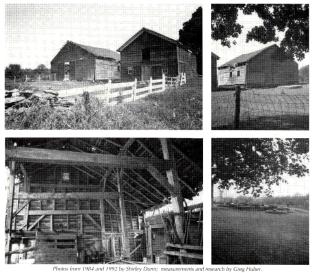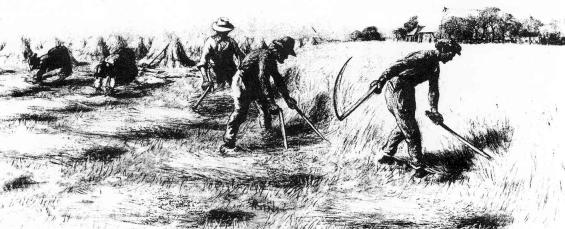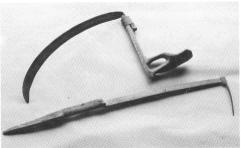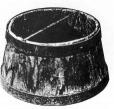|
Dutch
Barn Preservation Society
Dedicated
to the Study and Preservation
of New World Dutch Barns
NEWSLETTER
FALL 1992, Vol., 5, Issue 2
A
PHOTO ESSAY

The Dutch barn pictured stood on Wurtemburg Road, near Rhinebeck,
Dutchess County. When it was photographed eight years ago, a
survivor of over two centuries of service, the carved date of
1759 was visible in the center of the first anchorbeam. The structure,
a typical Dutch barn of three bays with a manger on the east
side, later collapsed.
The ruin was among Dutchess County barn sites visited by the
Dutch Barn Preservation Society trustees on a tour in May, 1992.
The foundation of the ruined barn measured 43' (width at the
gable end) by 42' deep; the anchorbeams were 11" by 8" supported
by 10" by 8 3/4"
columns. The threshing floor was 18' wide, flanked by 12' 6" aisles.
Named for an area in Germany, the Wurtemburg Road locale was
settled by Germans rather than by the Dutch. However, the owner/builder
of this particular barn is not known.
New World Dutch Farms: A
Selection of Distinctive Objects
By Roderic H. Blackburn with contributions
by Willis Barshied, Jaap Schipper and Anthony Sassi
Continued from the Spring, 1992, issue.
The Dutch Sith and Mathook
Among the hand tools that were distinctively Dutch were the sith
and mathook. Kiliaen Van Rensselaer in 1632 wrote to Wouter van
Twiller, his nephew and director of his colony of Rensselaerswijk
that he was sending
"12 grass scythes/19 sichten - [siths or Flemish scythes]
for grain". A ca. 1634 inventory for goods sent to the same
place listed "4 long grain scythes" and "4 sichten
- for grain".(1)
The sith [also designated as sicht, zicht, sicht, sythe, Flemish
scythe, Hainault scythe (a misnomer as in that province it was
not used) and other variations] was the reaping tool of Dutch preference
for centuries. Like the Dutch plow, it appears in 16th century
illuminated Flemish manuscripts(2) and later paintings and engravings.
From northern France to Northern Germany it had wide acceptance,
reflecting its greater efficiency over both the small sickle and
the large scythe. It allowed a man to stand nearly erect, the sith
balanced comfortably in his right hand, and slash the grain more
easily because the crooked shaped handle braced much of the effort
against his wrist and lower arm. Without his having to stoop over,
the reaping hook [mathook] in his left hand held the stalks together
at an angle to more easily cut them, then deftly position them
on the ground for subsequent binding into sheaves.
Typical of various references to the sith, Laurens van Alen, proprietor
of a farm in present Columbia County, in 1672 sued a tenant farmer
for
"certain missing tools, including a Flemish scythe, an auger,
a mattock, a flatiron, and a small fork." Yet, about one hundred
years later, Richard Smith wrote that "... a Scythe with a
Short crooked Handle and a Kind of Hook both used to cut down Grain
for the Sickle is not much known in Albany County or in this Part
of Duchess." (3)
A number of examples of the sith and mathook survive, most having
been found in the Mohawk Valley where Dutch (and German, for both
made and used identical objects there) farm practices persisted
into the mid-19th century, longer than elsewhere. One sith is marked
1821, and other blades are stamped for S. and A. Waters, makers
active from 1812 in Amsterdam, Montgomery County. Sith handles
show considerable variation, not only between European and American
versions, but within the existing American examples suggesting
regional and likely individual variation. Carved usually from two
pieces of wood, some are more finished than others, suggesting
that at least some were farm-made rather than craftsman-made. The
mathook was also carved to insure a comfortable grip and a similar
bracing of the long handle against the arm for greater leverage.
Not illustrated here, but worth mentioning, is a Dutch anvil and
hammer specifically made for sharpening the sith blade in the field.
The anvil is in the shape of a big cold chisel or wedge about a
foot long with a lower pointed end which is driven into the ground.
The upper end widens to receive the blows on the sith blade edge
using a special narrow-headed hammer.(4)
The sith and mathook were well suited to wheat (often called corn
in early accounts, especially by English speakers) harvesting.
They were also used for cutting peas, a crop which was often alternated
with wheat. In the province of Zealand in the Netherlands that
was their sole use.
Each shock of summer wheat contained twelve sheaves, each shock
of winter wheat or rye contained eighteen sheaves. In order to
dry the sheaves on all sides the shocks had to be turned.

In Uit Het Oude Friese Akkerbouwbedrij,
Leeuwarden, 1981. Illustrated by drawings done by Ida Wiersma
(1878-1965) ca. 1906-1932.
"At the wheat harvest the wheat was cut with the sith. The
cut stalks were shaped into a sheaf with the mathook and the right
foot. Then the sheaves were bound by the binders and finally put
in shocks to dry."
Curiously the
English showed persistent reluctance to adopt the sith despite
its efficiencies. Both in England, where it was advocated and
demonstrated without effect, and in New York when great numbers
of Yankees swept into New York after the Revolution, the Englanders
stuck to their own sickle and long-handled grass scythe. Only
in the nineteenth century when the demonstrably more efficient
cradle scythe was introduced and adopted by all ethnic groups
did the Dutch begin to give up the sith and mathook.
Other Dutch Objects
Of the hundreds of objects once part of Dutch farms only a fraction
can be physically identified today. Most objects have been lost
or destroY!2d and of those surviving most have lost their "Dutch" connection
to a specific family or farm. We have to rely on those few still
on family farms or in catalogued public and private collections
as a guide to what was characteristic of early farms in New York
and New Jersey. Most objects probably will prove to be so similar
to New England or European examples - early engravings and paintings
demonstrate how little many tools have changed - that their "Dutchness" will
never be obvious. Where an object has retained in English usage
its Dutch name (sith, mathook) or the word "Dutch" as
an adjective (Dutch plow, Dutch wagon),we can be more certain that
it was once viewed as distinctly Dutch in form or style. Such is
the case with the grain measure used by the New World Dutch which
retains its old name, schepel. Its capacity is certainly non English,
as it holds the odd amount of .764 English bushels. In Dutch measure,
three schepels equaled a zat, four zats a mudde, and 27 muddes
a last (85.512 bushels).
A whiffletree-like object was once identified by Rufus Grider,
a knowledgeable historian of Mohawk Valley life, as a "Dutch
neck yoke". How it and others could be used as such is not
clear from the several examples which have been found in the Mohawk
Valley. What distinguishes them from the more conventional whiffletree,
which connected a horse's two traces to the pulled object (plow,
wagon etc.) is the greater number of attaching swivels, eight instead
of two. One example survives with parts of the harness straps attached.
Less puzzling is the decorative iron work, which is shaped in a
heart design, a touching symbol of the farmer's true affections.

Sith and mathook found in Montgomery
County, NY. Collection of Willis Barshied.
 Schepel
used by Johannes Ball, chairman of the Committee of Safety, Schoharie
Frontier, during the Revolution. Height 10 inches, diameter 15
1/4 inches. Pine and wrought iron. Collection of the Schoharie
County Historical Society, Schoharie, NY. Schepel
used by Johannes Ball, chairman of the Committee of Safety, Schoharie
Frontier, during the Revolution. Height 10 inches, diameter 15
1/4 inches. Pine and wrought iron. Collection of the Schoharie
County Historical Society, Schoharie, NY.

"Dutch neck yoke", a whiffletree-like
object, the upper one with early harness straps. Collection of
Willis Barshied, Palatine Bridge, NY.
Another Dutch object is a type of harness composed of a chest
and shoulder strap, not the neck collar we associate with a working
harness. Examples have been found in the Mohawk Valley which match
illustrations of harnessed horses pulling wheel plows in the Netherlands.
Many "wagon seats" are circulating around the antiques
trade and may have been the type used on Dutch wagons, but one
description mentions wooden springs, not the well known chair posts.
And what of the carts mentioned in Dutch farm inventories? Not
one today is clearly identifiable as coming from a Dutch farm so
we don't know if it was as distinctive in construction as the Dutch
wagon.
One sleigh dating from the later part of the eighteenth century
with a tradition of ownership by General Peter Gansevoort of Albany(5)
may be Dutch in character.
Like so many of the objects listed in inventories, most will
await the stimulated inquiry of the reader to uncover them from
Dutch farms or from illustrations of Dutch objects in far flung
publications and art works. Let us share discoveries in the Newsletter
and Miscellany as they are found to build a useful archive of all
the objects which the mother of objects, the Dutch barn, has preserved
for us.
ENDNOTES
1. Van Laer, A. J. F., Van Rensselaer-Bowier Manuscripts.
Albany: University of the State of New York, 1908. p. 204. Ibid,
p. 264.
2. "The Month of August", from Hours of the Virgin
and Kalendar for Strassburg Use. Illustrated in Peter H.
Cousin's authoritative Hog Plow and Sith, Cultural Aspects
of Early Agricultural Technology, Dearborn: Greenfield Village
and Henry Ford Museum, 1973. p.23. The most complete source on
the sith, on which much of this section is based, comes from
this source.
3. Van Laer, A.J., Minutes of the Court of Albany, Rensselaerswyck
and Schenectady. Albany: University of the State of New York, 1926,
p.302. Smith, Richard, A Tour of Four Great Rivers/ the Hudson,
Mohawk, Susquehanna and Delaware in 1769/ Being the journal of
Richard Smith of Burlington, New Jersey, Edited by F. W. Halsey,
Port Washington, New York: Ira J. Friedman, 1964. p.11.
4. For further information on the sith, mathook, and other Dutch
farm tools see David Steven Cohen's "Dutch-American Farming:
Crops, Livestock, and Equipment, 1623-1900" in New World
Dutch Studies, Dutch Arts and Culture in Colonial America 1609-1776,
Roderic H. Blackburn and Nancy A. Kelley (eds.). Albany Institute
of History and Art, 1987, pp.194-198. For further information on
the sith see: "A Symposium, Questions about Dutch agricultural
tools in America." with contributions by Willis Barshied Jr. "In
defense of the term 'sith' " (pp.65-66); Francis York "Peculations
about the origin of the word mathook"
(pp.66-67); Charles Reichman "Barton of Mayfield and the Dutch
scythe"
(p.67); and Richard Kappeler "A Dutch? scythe anvil" (p.68).
This appeared in The Chronicle of the Early American Industries
Association, March, 1975. In the December 1987 issue, Willis
Barshied Jr. added an
"Editorial addendum" on the subject, and Robert Fridlington
wrote "Sith vs. scythe, another view"; followed by "The
pith of the matter, a response from the editor". Peter Sinclair
illustrated and discussed several Hudson Valley siths in "Five
siths and a mathook from Ulster County, NY" in Field Notes
of the Joy Farm Preservation Society, Autumn, 1991.
5. Collection of the Museums at Stony Brook, Stony Brook, Long
Island, NY.
Society Activities

DBPS members listened intently on June 16, 1992 to Ellen van Olst,
Director of the Stichting Historisch Boerderij-onderzoek, a barn
preservation group headquartered at Arnhem, The Netherlands, as
she showed slides illustrating regional differences in barns in
the Netherlands. From left, Jack Sobon, who arranged the talk in
connection with the Timber Framers Guild, R. Andrew Nash (rear),
Michael Bathrick, Rivkah Feldman, and Harold Zoch. Photo by Clarke
Blair.
Differences noted by Ms. van Olst between old barns in the Netherlands
and Dutch barns near Albany included: multiple use there rather
than single use; smaller scantlings (timbers) and imperfect timbers
used in Netherlands barns; floors in Netherlands barns made of
clay, not wood, with no flooring framework, and posts resting on
stones; roofs in the Netherlands covered with thatch or pantiles;
siding there may be wattle and-daub or brick infill between posts
(studs); lower aisles (eaves) in the Netherlands; house (residence)
may be attached at one end.
|